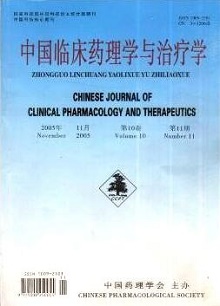Setting uPpopulation pharmacokinetics/pharmacodynamics model of VPA n children with epilepsy by NONMEM software
JIANG De-chun, WANG Li, LU Wei
2005, 10(11):
1279-1289.
 Asbtract
(
215 )
Asbtract
(
215 )
 PDF (285KB)
(
306
)
References |
Related Articles |
Metrics
PDF (285KB)
(
306
)
References |
Related Articles |
Metrics
AIM: To set uPpopulation pharmacoki-netics/pharmacodynamics(PPK/PD)model of valproate(VPA)in children with epilepsy in China,and promote easonable use of antiepileptic drugs(AEDs)in clinical ractice.METHODS: Sparse data of VPA serum con-centrations from 246 pediatric children were collected.These patientswere divided into three groups:PPK-Model rouP(n =146),to calculate PPK parametervalues of PA and set uPa PPK model;PPK-Valid grouP(n =100),to valid the PPK model;and PPD grouP(n =69),to set uPPPK PD model.Based on the data of PK-Model grouPand PPK-Valid group,a PPK model of PA in children with epilepsy in China was successfully et uPby using NONMEM software by ourselves.Now,using the data of 69 patients in PPD grouPwho were on PA monotherapy and this PPK model,we set uPPPK/PD model by NONMEM software.Efficacy of epilepsy treatment was divided into 5 grades according to the per-centage of seizure frequency decreased(PSFD%):grade 1:PSFD%was 100%;grade 2:PSFD%was 75%-100%;grade 3:PSFD% was 50%-75%;grade 4:PSFD% was 25%-50%;grade 5:PSFD%was less than 25%.The quantitive relationshiPbetween the VPA serum concentrations and the probability forits efficacy score was characterized by Logistic regression analysis with NONMEM.RESULTS: Logistic regression analysis showed that,VPA serum concentrations and the proba-bility forits efficacy grades 5,4,3,2,and 1 were(23μg·ml-1,5,50%),(30μg·ml-1,4,32.3%),(50μg·ml-1,3,26.3%),(65μg·ml-1,2,36.5%),(78μg·ml-1,1,50%),and(100μg·ml-1,1,84.2%)respectively.CONCLUSION: A PPK/PD mod-el of VPA in children with epilepsy in China is success-fully established by using NONMEM software,and the probability of efficacy grade forany concentration can be calculated.It will be valuable to facilitate individualized dosage regimen.


